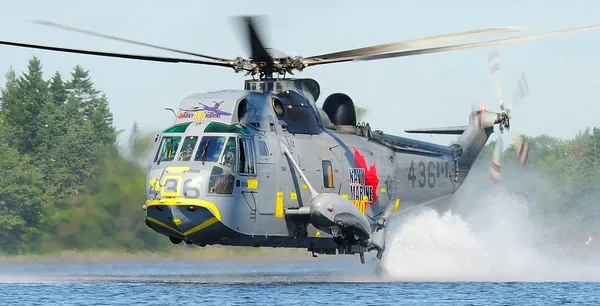Mander, Douglas Norman
Killed in Flying Accident 1967-12-01

Birth Date: 1935-March-13
Born: Toronto, Ontario
Son of Norman and Gillian V. Mander.
Home: Toronto, Ontario
Enlistment:
Enlistment Date: Unknown
Service
RCN
Unit
50 (AS) Sqn- Squadron (RCN)
Base
HMCS BONAVENTURE
Rank
Petty Officer 1st Class
Position
Petty Officer 1st Class
Service Numbers
N27250
Home
 Toronto, Ontario
Toronto, Ontario
First Burial
 Burial At Sea *n/A*
Burial At Sea *n/A*
Sikorsky CHSS-2 Sea King CH-124/A/B/-2

Sikorsky CH-124 Sea King (Serial No. 4036), during waterbird training at Morris Lake, Dartmouth, Nova Scotia, 2011
The Sikorsky CH-124 Sea King is a twin-engined anti-submarine warfare (ASW) helicopter designed for shipboard use by Canadian naval forces, based on the US Navy's SH-3. It served with the Royal Canadian Navy (RCN) and Canadian Armed Forces from 1963 to 2018.
The advent of nuclear-powered attack submarines in the late 1950s prompted RCN leaders to assess the new threat they posed. Although these craft were noisier than older submarines and could therefore be detected at longer ranges, they were also capable of 30 knots (56 km/h) while submerged, which was faster than the top speed of the RCN's new St. Laurent-class destroyer escorts at 28.5 knots (52.8 km/h). Some RCN leaders harbored serious doubts that the destroyers could effectively pursue and destroy such fast vessels, even when operating in pairs. During a 25 February 1959 meeting of the Naval Board, it was decided that the Navy would counter the new threat by outfitting destroyers for helicopter operation.
The first of 41 helicopters would be delivered in 1963 carrying the designation CHSS-2 Sea King. The airframe components were made by Sikorsky in Connecticut but most CHSS-2s were assembled in Longueuil, Quebec, by United Aircraft of Canada (now Pratt & Whitney Canada), a subsidiary of Sikorsky's parent company, United Aircraft. On 27 November 1963, the new landing platform aboard HMCS Assiniboine was used for the first operational destroyer landing of a production CHSS-2. Upon the unification of Canada's military in 1968, the CHSS-2 was re-designated CH-124.
In the 1960s, the RCN developed a technique for landing the huge helicopters on small ship decks, using a 'hauldown' winch (called a "Beartrap"), earning aircrews the nickname of "Crazy Canucks". The Beartrap allows recovery of the Sea King in virtually any sea state. In 1968, the RCN, Royal Canadian Air Force (RCAF) and Canadian Army unified to form the Canadian Forces; air units were dispersed throughout the new force structure until Air Command (AIRCOM) was created in 1975. Wikipedia

 Canadian Virtual War Memorial
Canadian Virtual War Memorial www.findagrave.com
www.findagrave.com
 Wikipedia Sikorsky CH-124 Sea King
Wikipedia Sikorsky CH-124 Sea King Harold A Skaarup Web Page
Harold A Skaarup Web Page CH-124 Sea King Kestrel Publications
CH-124 Sea King Kestrel Publications